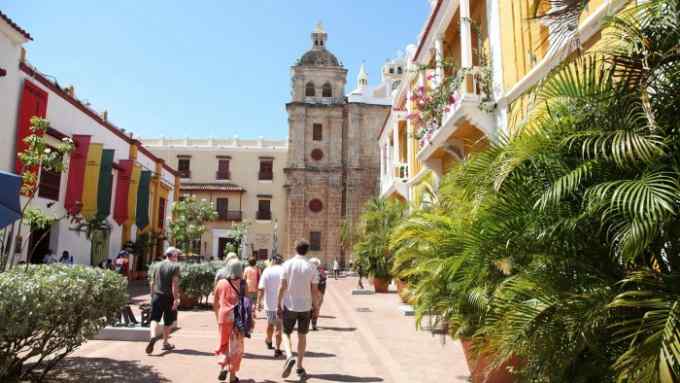Colombia pushes ahead with ambitious infrastructure plan

Roula Khalaf, Editor of the FT, selects her favourite stories in this weekly newsletter.
In most countries, 4G and 5G refer to advances in mobile telephony. In Colombia the terms are synonymous with roads, airports, railways, rivers and canals.
Ever since the 1990s, Colombia has unveiled its forthcoming infrastructure projects in great packages, each described as “a new generation”.
The most recent was the fourth generation (4G) programme, launched in 2014. It was the biggest investment initiative in the country’s history: 29 projects to build or renovate 5,000km of roads, 775 bridges and 41 tunnels at a cost of about $13bn.
The programme was to end in 2022 but has faced serious delays, due partly to flaws in the design of contracts and partly to the fallout of Latin America’s Odebrecht corruption scandal, in which the Brazilian construction company paid bribes across the region to win contracts, including in Colombia. (The scandal led to a review of all 4G infrastructure projects, some of which were modified while work was halted.)

When the current government of Iván Duque picked up the 4G baton following his election in 2018, the programme was only 16 per cent complete. It is now more than 40 per cent done, but there is more to do.
That is bad news for Colombians, who are crying out for better infrastructure and were hoping it would be finished by now. But it is good news for foreign investors: the 4G projects still offer opportunities.
“The door is not closed. Quite the opposite,” says transport minister Ángela María Orozco. “There are opportunities to finance ongoing projects but there’s also scope for companies to come in, buy an asset that’s already been built — where the primary risk has already been taken — and then operate it.”
Many foreign companies have already jumped into 4G. The China Harbour Engineering Company, Portugal’s Mota-Engil, Spain’s Grupo Ortiz, Israel’s Shikun & Bunui and the UK’s John Laing are all busy building Colombian roads. Over half the projects have foreign funding, mostly from the US but also Japan, Brazil, France and Spain.
“It’s becoming quite cosmopolitan,” says Manuel Felipe Gutiérrez, director of the national infrastructure agency ANI. “Colombia is attracting funds like Ashmore, BlackRock and Morgan Stanley, as well as foreign construction firms.”
Alex Yew, managing director for Latin America at John Laing, describes his company’s experience of expanding and improving the Ruta del Cacao — a 152 km road in northern Colombia, as “generally positive”.

“We’ve found it to be a very open and welcoming environment for foreign investors. We have a great team and great partners and we’re definitely committed to the country.”
As the 4G projects move towards completion (expected sometime around 2027) attention is turning to what comes next: the 5G programme. The government has been outlining its plans in recent weeks.
The programme will be split in two. The first will consist of 12 projects to be tendered over the next year with a combined capital expenditure of more than $5bn. Unlike the 4G programme, which focused on road-building, these schemes cover road, rail, air and river transport.
Perhaps the most eye-catching of the 5G projects are on water: the dredging of the mighty Magdalena River and the renovation of the Canal del Dique, constructed by the Spanish in the late 16th century.

The Magdalena used to be the main transport link between the coast and Colombia’s mountainous interior. In its heyday, great triple-decker steamboats plied its waters. Gabriel García Márquez, the Nobel Prize-winning novelist, immortalised the river in Love in the Time of Cholera and The General in his Labyrinth.
Today, much of the river is silted up and impassable for all but the smallest boats. Engineers will be tasked with dredging 657km of it — the distance from London to central Scotland — while rebuilding levees around Barranquilla, where the Magdalena meets the sea. The project is expected to triple the flow of cargo on the river.
Renovating the Canal del Dique is an equally daunting prospect. The Spanish built it to link the colonial port of Cartagena to the Magdalena. The canal was plagued with problems throughout its history. It silted up and became severely eroded. In 2010 it burst its banks, killing livestock and ruining crops.

The project, like the Magdalena dredging plan, will be a public-private partnership.
Once the first 12 projects are up and running, the state will embark on phase II of 5G, although most of that will fall to the next government after 2022. These projects include an upgrade to Bogotá’s main airport and the expansion of the highway linking the southern cities of Popayán and Pasto.
Colombia desperately needs these upgrades. Poor infrastructure has long stopped it from realising its potential, despite a strong business culture.
When the World Economic Forum produced its most recent Global Competitiveness Index, it ranked Colombia 57th among 141 countries, but when it came to the quality of its road infrastructure, it was 104th.
This is partly due to formidable geography. Colombia is cut through by three big mountain ranges. Elsewhere there are swamps and dense jungle. For civil engineers, the country is either a headache or a fabulous challenge, depending on how they look at it.
But despite the challenges, the government and the ANI are confident they cannot only shepherd the 4G projects towards completion but also get the 5G projects off to a good start.”
“They’re incredibly important to us Colombians,” Mr Gutiérrez says.

Comments